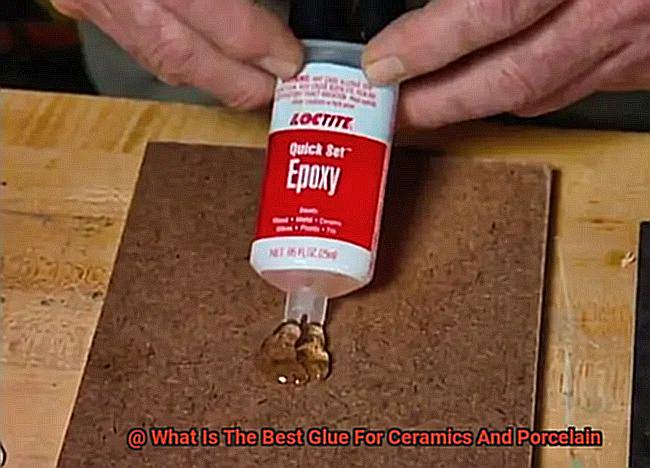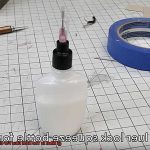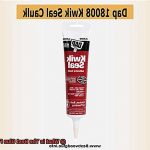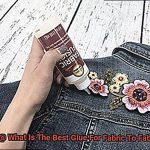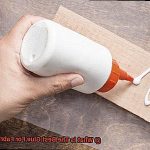Are you tired of struggling to find the perfect glue to fix your delicate ceramics and porcelain items? Do you wish there was a reliable adhesive that could effectively hold your damaged belongings together without the risk of them falling apart again? Look no further. In this blog post, we will delve into the world of ceramic and porcelain glue and help you find the best one for your needs.
Ceramics and porcelain pieces are some of the most fragile items in our homes. From cherished heirloom plates to decorative figurines, it’s essential to find a glue that won’t leave unsightly marks or residue. We’ll explore the different types of glues available, including their strengths and weaknesses, so you can make an informed decision about which one is best suited for your specific needs.
Whether you’re a DIY enthusiast or a professional ceramic artist, having the right adhesive on hand is crucial to ensuring that your broken items are repaired smoothly without causing additional damage. We’ll reveal some expert tips and tricks to help make the gluing process easier and more effective, as well as how to properly care for your repaired items once the glue has dried.
By the end of this blog post, you’ll be equipped with all the knowledge and resources necessary to choose the perfect glue for your ceramic and porcelain needs. Say goodbye to frustration and hello to restored precious possessions.
Understanding Different Types of Glue
Contents
- 1 Understanding Different Types of Glue
- 2 Pros and Cons of Cyanoacrylate (Super Glue)
- 3 Benefits of Epoxies for Ceramics and Porcelain
- 4 Specialized Ceramic and Porcelain Glues
- 5 Factors to Consider When Choosing the Right Glue
- 6 Steps for Preparing Ceramics and Porcelain for Gluing
- 7 Tips for Applying Glue on Ceramics and Porcelain
- 8 Troubleshooting Common Glue Problems
- 9 Conclusion
Ceramics and porcelain are renowned for their beauty and elegance. However, accidents happen, and these delicate materials can easily become damaged. In such cases, choosing the right glue is essential. Here are some factors to consider when selecting the best adhesive for your project:
Type of Glue
The market offers various types of glue for use on ceramics and porcelain, including epoxy, cyanoacrylate, and polyurethane glue. Each type has its own set of advantages and disadvantages. For instance, epoxy glue is known for its strong bonding properties and dries clear, making it ideal for objects where appearance is essential. Cyanoacrylate glue bonds quickly and forms a strong bond between the surfaces being glued together. Polyurethane glue expands as it dries, filling in gaps or cracks between surfaces.
Size of Project
The size of the repair or project you’re working on is a crucial factor to consider when selecting an adhesive. For smaller repairs or bonding small pieces together, a fast-drying adhesive like cyanoacrylate may be suitable. However, for larger projects or repairs that require a stronger bond, an epoxy or polyurethane glue may be a better choice.

Materials Being Bonded
Different glues work better with certain types of materials than others. If you’re bonding ceramic or porcelain to another material like metal or plastic, epoxy may be the best choice. If you need to fill gaps or cracks between surfaces, polyurethane glue may be more suitable.
Strength Required
The amount of strength required for the bond is another critical factor to consider. For instance, if you’re repairing a fragile porcelain figurine, a fast-drying adhesive like cyanoacrylate may be sufficient. However, if you’re repairing a ceramic vase that will hold water and flowers, a durable bond from an epoxy or polyurethane glue would be necessary.
Manufacturer’s Instructions

Before selecting a glue for your specific project, always read the manufacturer’s instructions carefully. Following the instructions can ensure a successful bond and prevent damage to the surface.
In conclusion, choosing the right glue for ceramics and porcelain can be a daunting task. However, by considering factors like the type of glue, size of the project, materials being bonded, strength required, and manufacturer’s instructions, you can make an informed decision. With the right adhesive, you can restore your ceramics and porcelain to their former beauty and ensure a long-lasting bond.
Pros and Cons of Cyanoacrylate (Super Glue)
If you’re in need of a quick-drying and strong adhesive for your ceramic or porcelain project, cyanoacrylate, commonly known as super glue, may seem like the perfect solution. However, before diving into any project, it’s important to consider the pros and cons of using this popular adhesive.
On the positive side, one of the major benefits of using cyanoacrylate is its ability to dry quickly. In just a few seconds, the adhesive can create a bond that can withstand high temperatures and pressure. This makes it a convenient option for smaller projects or repairs that require immediate attention.
Moreover, cyanoacrylate creates a strong bond that can endure over time, making it an excellent choice for ceramics and porcelain objects. It can provide reliable and durable results when used correctly.
However, there are downsides to using cyanoacrylate. One of the most significant disadvantages is that it can be challenging to remove once applied. Additionally, it may leave behind residue or discolouration on the surface of your ceramic or porcelain object. This issue can be particularly problematic if the object is highly visible or has intricate designs.
Another factor to consider is that cyanoacrylate is not suitable for use on porous surfaces such as unglazed ceramics. The adhesive may not dry correctly or may seep into the pores of the material, compromising its strength and durability.
Finally, we must note that cyanoacrylate can be toxic if ingested or inhaled. It’s crucial to use this adhesive in a well-ventilated area and take necessary precautions to avoid accidental ingestion or inhalation.
Benefits of Epoxies for Ceramics and Porcelain
While cyanoacrylate may be a common choice, let me tell you about the game-changing benefits of epoxies.

First and foremost, epoxies are known for their superior strength and durability. When bonding ceramic and porcelain materials, the chemical reaction curing process creates a bond that can withstand stress and strain, ensuring your projects will last for years to come.
In addition to their strength, epoxies are also resistant to water and other liquids. This is particularly useful for bathroom and kitchen tiles, where exposure to moisture is a constant concern. With epoxies, you can rest assured that your tiles won’t become damaged or come loose due to water exposure.
But that’s not all – epoxies can also handle high temperatures with ease. With the ability to withstand up to 300 degrees Fahrenheit, they are perfect for use in high-heat environments like ovens and stoves.
Perhaps the most impressive benefit of epoxies is their versatility. No matter what type of ceramic or porcelain material you’re working with – whether it’s small tiles or large sculptures – epoxies can handle it all. Their adaptability makes them ideal for both home and industrial applications.
Specialized Ceramic and Porcelain Glues
Crafted with cyanoacrylate, epoxy, or polyurethane as the primary bonding agent, these glues are specifically formulated to bond ceramics and porcelain with superior strength and durability. Here are just a few advantages of using specialized ceramic and porcelain glues:
- Clear and Invisible Bonding: One of the best things about these glues is their ability to dry clear and almost invisible once cured. This makes them perfect for repairing delicate or decorative pieces where aesthetics are essential. You won’t even know it’s there.
- Resistance to Water, Chemicals, and Heat: Specialized ceramic and porcelain glues offer excellent resistance to water, chemicals, and heat, making them ideal for use in environments where these factors may be present. So go ahead and put your favorite mug in the dishwasher without worrying about it falling apart.
- Strong and Lasting Bond: With specialized ceramic and porcelain glues, you can be confident that your creations will last for years to come. They provide a strong and lasting bond that can withstand high temperatures and pressures that ceramics and porcelain may be subjected to.
It’s important to note that not all specialized ceramic and porcelain glues are created equal. Some may work better on certain types of ceramics or porcelains than others. Therefore, it’s recommended to choose a glue that is specifically designed for the type of material you are bonding.
Factors to Consider When Choosing the Right Glue
Choosing the right glue is essential to fix these delicate materials. But with so many options available on the market, it can be challenging to know which one to choose. To help you make the right choice, there are several factors you should consider when selecting a glue for ceramics and porcelain.
Firstly, consider the type of ceramic or porcelain you are repairing. Some types of ceramics and porcelain are more porous than others, which means they require a different type of glue. For instance, if you’re fixing a fine china teacup, a specialized adhesive that can penetrate the porous material without damaging it is essential. On the other hand, a ceramic garden pot requires a different type of glue.
Secondly, think about the strength of the bond required. If you’re repairing a decorative piece that won’t undergo any stress or strain, then a weaker glue will suffice. However, if you’re repairing something that will be used regularly, such as a ceramic mug or bowl, then you’ll need a stronger adhesive that can withstand frequent use.
Thirdly, consider the drying time of the glue. If you’re fixing a small crack or chip, then a quick-drying glue may be ideal. However, if you’re repairing a larger piece or multiple pieces, then you may need a slower-drying glue that gives you more time to position the pieces correctly.
Finally, think about the appearance of the finished repair. Some glues dry clear or translucent, while others dry white or yellowish in color. If you’re repairing something that will be visible and on display, such as a porcelain figurine, then choosing a glue that dries clear will ensure that the repair is less noticeable.
Steps for Preparing Ceramics and Porcelain for Gluing
With the right knowledge, you can fix it with ease and confidence. Before we dive into the best glue options for ceramics and porcelain, let’s discuss the essential steps for preparing these materials for gluing.
First things first, cleanliness is key. Dirt, dust, or debris on the surface can prevent the glue from adhering properly, so take a gentle cleanser and a soft cloth to clean the surfaces thoroughly. Avoid using harsh chemicals or abrasive materials that can scratch or damage the surface.
Next up is roughening up the surface of the ceramics or porcelain using sandpaper or a file. This may sound counterintuitive, but trust us, it’s necessary. Roughening up the surface creates more area for the glue to adhere to and increases the strength of the bond. However, be cautious not to apply too much pressure or sand too aggressively as this can damage the surface.
Once you’ve roughened up the surface, it’s essential to ensure it’s completely dry before applying the glue. Any moisture on the surface can prevent the glue from bonding properly, so give it some time to air dry completely or use a hairdryer on low heat to dry them more quickly.
Lastly, we recommend testing a small amount of glue on a hidden or inconspicuous area before applying it to larger surfaces. This way, you can ensure that the glue adheres correctly and doesn’t damage or discolor your ceramics or porcelain.
Tips for Applying Glue on Ceramics and Porcelain
When it comes to repairing ceramics and porcelain, applying the glue correctly is crucial. Here are five tips to help you achieve a strong and lasting bond.
Clean the surfaces
Before applying any glue, make sure that the surfaces of the ceramics or porcelain are clean and free from any dirt, dust, or debris. Even a small amount of debris can cause the bond to be weaker. Use a mild detergent and warm water to clean the surface, and then dry it thoroughly.
Use a small amount of glue
When applying glue, less is more. A small amount of glue can go a long way in bonding ceramics and porcelain. Apply the glue in thin layers using a toothpick or a small brush to ensure that you do not apply too much. This will help avoid excess glue that can cause a weaker bond.
Be patient
The drying time for ceramic and porcelain glues can vary depending on the type of glue you are using. Be patient and wait for the recommended drying time before handling or moving the object. Rushing the process may lead to a weaker bond or even breakage.
Clamp if necessary
If you are gluing larger pieces of ceramics or porcelain together, you may need to use clamps to hold them in place while the glue dries. It is important to use gentle pressure with padded clamps or tape to avoid cracking or damaging the delicate surface. Placing a protective layer between the clamp and the surface will prevent damage.
Sand if needed
If there are any rough surfaces on the ceramics or porcelain, you may need to sand them down before applying the glue. This will ensure that the surfaces are smooth and will bond properly, leading to a stronger bond.
Troubleshooting Common Glue Problems
Many craft enthusiasts encounter common glue problems such as bonding, residue, and drying time. But fear not, as an expert on troubleshooting these issues, I’m here to help you out.
Firstly, let’s discuss the issue of bonding. When your glue doesn’t bond properly, it can be disappointing and frustrating. To avoid this problem, make sure to select the right type of glue for your project and follow the manufacturer’s instructions carefully. Apply enough pressure and allow sufficient drying time before handling the project.
Another common problem is when the glue leaves a residue or doesn’t dry clear. Nobody wants a sticky mess on their masterpiece. To prevent this, use the recommended amount of glue and spread it evenly over the surface. Additionally, check the expiration date of your adhesive to ensure it’s still effective.
Lastly, let’s talk about drying time. If your glue dries too quickly or too slowly, it can throw off your entire project timeline. To avoid this issue, work in a well-ventilated area with moderate temperatures and humidity levels. You can also use a fan or heater to regulate air circulation and temperature if necessary.
MSl0EeKgeEs” >
Conclusion
In conclusion, selecting the best adhesive for your ceramics and porcelain repairs is paramount to safeguarding your delicate items from further damage. The abundance of options available on the market can be overwhelming, but by taking into account factors such as glue type, project size, materials being bonded, strength required, and manufacturer’s instructions – you can make an informed decision.
When it comes to ceramic and porcelain glue types, cyanoacrylate, epoxy, and polyurethane are popular choices. Depending on your project’s requirements, each adhesive has its own set of advantages and disadvantages. It’s crucial to consider factors such as project size, materials being bonded together and strength required before settling on a specific adhesive.
Preparing surfaces for gluing is equally important in ensuring a successful bond. Thoroughly cleaning surfaces with mild detergent and warm water eliminates any dirt or debris that could weaken the bond. Roughening up surfaces using sandpaper or a file creates more area for the glue to adhere to – ultimately increasing the bond’s strength.
Following expert tips when applying glue is essential in achieving a strong and lasting bond between your ceramics or porcelain pieces. Using small amounts of glue in thin layers, practicing patience during drying time and clamping if necessary are all crucial steps.
Lastly, troubleshooting common glue problems such as bonding issues or residue can be easily avoided by selecting the right type of glue for your project and carefully following manufacturer instructions.

